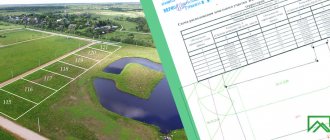In accordance with current legislation, easement means the possibility of partial use of someone else's real estate.
When registering an easement, you will need to collect the following documents: an application, a receipt for payment of the state duty, a passport or constituent documents (for a legal entity) and documents of ownership of real estate or land.
To ensure that no controversial issues arise in the future between the parties to the easement agreement, it is worthwhile to spell out all the nuances as much as possible in the concluded agreement.
Namely:
- Subject of the agreement. In this paragraph, you should write in full all the rights that are granted to the servitude in relation to someone else’s property (land plot). It is necessary to indicate information about the site (building, structure), which allows you to establish its exact location (cadastral number, address). If possible, it is necessary to mark on the plan of the encumbered property where exactly the easement will be implemented. In accordance with current legislation, a plan with a marked easement is an integral annex to the agreement;
- Purposes of establishing an easement. This agreement is drawn up in cases where travel or passage is necessary, power lines and communications through someone else's property (land plot) or other needs that cannot be satisfied without the establishment of an easement. This type of agreement is concluded in exceptional cases when it is not possible to meet the existing needs of the property owner, however, this agreement should not cause inconvenience for the owner servicing the land plot (structure, building;
- Methods of burdening. The contract must reflect its scope, all rights and obligations of the parties;
- Pay. In current legislation there are two types of easements: paid and gratuitous. In the case when a fee is established, it must correspond to the material benefit that the owner could receive if the property were not encumbered by an easement (for example, renting out part of the property to third parties). The size of the fee is also greatly influenced by the purpose for which the easement is established. In the case of travel or passage, you need to take into account the fact of maintaining the road surface in a suitable condition, etc.;
- A mandatory clause of the contract must be the responsibility of the parties;
- Validity. In most cases, the easement is established indefinitely, but there are exceptions.
Rights and obligations of the servituary:
- The right to use someone else’s property, observing all the conditions of the easement;
- When the owner of the encumbered property changes, the easement has the right to preserve the easement;
- The servitude cannot change the purpose of the object; all its rights are specified by scope;
- The servitude’s responsibilities include registering the agreement with government agencies and paying all associated expenses;
- Upon expiration of the contract, the easement is obliged to terminate the easement and register it with the authorized body.
Rights and obligations of the owner:
- The owner is obliged to provide assistance in establishing an easement (to provide all the necessary documents for registration of this agreement);
- The owner is obliged to ensure compliance with the terms of the easement agreement in a passive or active form. He must not take any action that might prevent the servitor from using the property;
- The owner has the right to demand from the servitude timely payment for the use of the property in the amount determined by the terms of the agreement;
- The owner has the right to demand termination of the easement if this is provided for by the legislation of the Russian Federation.
Dear readers! Our articles talk about typical ways to resolve legal issues, but each case is unique. If you want to find out how to solve your specific problem, please contact the online consultant form on the right. It's fast and free! Or call us at :
+7 Moscow, Moscow region
+7 St. Petersburg, Leningrad region
8 Federal number (free call for all regions of Russia)!
Conditions for establishing an easement
The variety of options that require the establishment of an easement boils down to its expediency.
It is not established without special reasons that force an individual or legal entity to apply to the owner of the site for permission to use part of its territory. The purpose of such an easement is a compensated restriction of the right to use the site on the part of the owner, which arises in the direction of the applicant for the part of the land plot alienated in his favor.
It is established at the initiative of the owner of the property, which requires placement on the encumbered site. Or - at the initiative of the customer (performer) of work that requires the use of the territory of the encumbered plot.
In this case, there is always a cause-and-effect relationship between the need of one person and the ability to satisfy it on the part of another. These reasons may include:
- the need to access the roadway;
- passage to water resources;
- passage to your own house through the neighbors' plot;
- someone else's property located on the owner's property;
- installation of a boiler or linear facilities by legal entities;
- conducting communications through the neighbors' property;
- similar reasons.
The right of perpetual
or fixed-term use allows the use of one person’s land to solve the problems of another, which creates a symbiosis of advantages and expansion of the boundaries of possibilities, if the parties can agree.
Voluntary encumbrance is carried out on the basis of proportionate payment, when the party using the owner’s land compensates him for losses caused by alienation and provides for payment of compensation for lost profits.
In addition, at the time the encumbrance is established, the person who received the easement is responsible for the management of the site, preserving the land property in proper form. The use of the encumbered part is permitted only in accordance with the purposes officially legitimized as a result of the agreements.
In turn, the owner of the land plot allows the free use of the agreed part of the land plot under the terms and conditions reached by agreement. His responsibility includes maintaining established boundaries, as well as clearing space near the limited territory.
In this case, it is NOT ACCEPTABLE:
- go beyond the category of land and its intended purpose;
- cause damage to the top fertile layer of soil;
- pollute the environment;
- influence areas owned by third parties.
It is imperative to comply with sanitary and fire safety measures.
What is a land easement?
An agreement that implies a limited right to use a plot of land on a paid or free basis is called a land easement. The person is not the owner of the plot, but according to the agreement drawn up, he has the right to carry out certain types of activities on the land.
The document may imply the payment of a certain type of payment for the use of someone else's property. At the same time, the owner of the plot on which the easement is imposed is not deprived of ownership rights and can dispose of the land according to his own discretion, without violating the conditions stipulated in the document.
Note! The territory of land on which the easement is assigned is not subject to transfer to another owner or sale. If the land is somehow transferred to another owner (for example, by will), the easement on a certain territory remains in effect.
Types of easements
Easements on a land plot are of the following types:
- Private easement - implies the delimitation of rights to the land territory of two neighboring parties. For example, for cases where two neighboring areas have a common demarcation zone, about which regular disputes arise. In this case, an easement may be imposed on this plot of land by a judicial organization.
- Public easement – in the event that controversial issues arise between the private owner and government agencies. Such cases include the construction of roads and other communications. A public easement is imposed on the territory of the land with certain conditions for the use of the allocated plot.
Such types of disputes are resolved only in judicial authorities after filing an appropriate application.
Agreement on the establishment of a private easement of land
G.
"__" ____ 2014
_______ represented by _______, acting on the basis of _______, hereinafter referred to as the “Owner”, on the one hand, and _______ represented by _______, acting on the basis of _______, hereinafter referred to as the “User”, on the other hand, hereinafter referred to as the “Parties”, have entered into this agreement, hereinafter referred to as the “Agreement”, as follows:
SUBJECT OF THE AGREEMENT
1.1. The Owner, in accordance with the terms of this agreement, grants the User, in order to ensure _______, the right of limited use (easement) of a land plot owned by the Owner by right of ownership, located at the address: _______.
1.2. The easement under the terms of this agreement is established in the interests of the User, who is the owner/user on the right of lifelong inheritable possession or permanent use/of the neighboring land plot No.___, adjacent to the Owner’s land plot on the _____ side.
1.3. The boundaries of the easement are determined on a copy of the Owner’s land plot plan, which is an integral part of this agreement.
1.4. The easement is established for a period of _____ until “__”____2014.
1.5. The use of a land plot belonging to the Owner is carried out by the User free of charge.
RESTRICTED USE PROCEDURE
2.1. Limited use (easement) of the Owner's land plot is carried out by the User strictly within the boundaries defined in accordance with clause 1.3. agreements.
2.2. The implementation of the easement by the User should be the least burdensome for the land plot of the Owner in respect of which it is established.
2.3. The implementation of the easement by the User occurs in the following order _______.
RIGHTS AND OBLIGATIONS OF THE PARTIES
3.1. The owner is obliged:
3.1.1. Provide the necessary assistance to establish an easement on the land plot owned by him.
3.1.2. Carry out the required actions to register the easement in the manner prescribed by law, including providing the necessary title and other documents.
3.1.3. Provide the User with the opportunity to exercise the easement in the manner prescribed by this agreement.
3.2. The owner has the right to demand termination of the easement due to the disappearance of the grounds on which it was established.
3.3. The user is obliged:
3.3.1. Implement the easement in the manner prescribed by Section 2 of this agreement.
3.3.2 Carry out all the required actions to register the easement in the manner prescribed by law.
3.3.3. When implementing an easement, strive to fulfill the condition of clause 2.2. present agreement.
3.3.4. Upon the occurrence of the event specified in clause 1.4. agreement to terminate the easement and take all necessary actions to register its termination with the authorized body.
FINAL TERMS
4.1. The easement is subject to state registration with the authorized body in accordance with the Federal Law “On state registration of rights to real estate and transactions with it.” The easement comes into force after its registration in the Unified State Register of Rights.
4.2. The easement is preserved in the event of transfer of rights to the land plot, which is encumbered by the easement, to another person.
4.3. An easement cannot be an independent subject of sale or purchase, or a pledge, and cannot be transferred in any way to persons who are not the owners of the land plot, to secure the use of which the easement is established.
4.4. This agreement comes into force upon signature by the parties. The agreement is drawn up in three copies, one for each party and for the registering authority.
LEGAL ADDRESSES AND BANK DETAILS OF THE PARTIES
Owner Jur. address: Postal address: INN: KPP: Bank: Cash/account: Correspondent/account: BIC:
User Legal address: Postal address: INN: KPP: Bank: Cash/account: Correspondent/account: BIC:
SIGNATURES OF THE PARTIES
Owner_________________
User_________________
AGREEMENT ON THE ESTABLISHMENT OF PRIVATE EASEMENT (TERMINAL, FREE OF CHARGE) OF LAND
AGREEMENT N ____ on the establishment of a private easement (urgent, gratuitous) of a land plot in the city of ______________ "__"__________ ____ the city of __________________, hereinafter referred to as the "Owner", on the one hand, and _____________, hereinafter referred to as the "User", on the other hand , have entered into this agreement as follows: 1. SUBJECT OF THE AGREEMENT 1.1. The Owner, in accordance with the terms of this agreement, provides the User with the right of limited use (easement) of the land plot owned by the Owner by right of ownership, located at the address: _______ ___________________________, in order to ensure _________________ (indicate the basis(s) on which the easement is established) the right of limited use (easement). 1.2. The easement under the terms of this agreement is established in the interests of the User, who is the owner (user on the right of lifelong inheritable possession or permanent use) of the neighboring land plot No. __________, adjacent to the land plot of the Owner on the _____________ side. 1.3. The boundaries of the easement are determined on a copy of the Owner’s land plot plan, which is an integral part of this agreement. 1.4. The easement is established for a period of __________ to _____________ (an event in the future may be indicated upon the occurrence of which the easement must be terminated). 1.5. The use of a land plot belonging to the Owner is carried out by the User free of charge. 2. RESTRICTED USE PROCEDURE 2.1. Limited use (easement) of the Owner's land plot is carried out by the User strictly within the boundaries defined in accordance with clause 1.3 of the agreement. 2.2. The implementation of the easement by the User must be the least burdensome for the land plot of the Owner in respect of which it is established. 2.3. The implementation of the easement by the User occurs in the following order: _________________________________. 3. RIGHTS AND OBLIGATIONS OF THE PARTIES 3.1. The owner is obliged: 3.1.1. Provide the necessary assistance to establish an easement on the land plot owned by him. 3.1.2. Carry out the required actions to register the easement in the manner prescribed by law, including providing the necessary title and other documents. 3.1.3. Provide the User with the opportunity to exercise the easement in the manner prescribed by this agreement. 3.2. The owner has the right to demand termination of the easement due to the disappearance of the grounds on which it was established. 3.3. The user is obliged to: 3.3.1. Implement the easement in the manner prescribed by Section 2 of this agreement. 3.3.2. Carry out all the required actions to register the easement in the manner prescribed by law. 3.3.3. When implementing an easement, strive to comply with the condition of clause 2.2 of this agreement. 3.3.4. Upon the occurrence of the event specified in clause 1.4 of the agreement, terminate the easement and take all necessary actions to register its termination with the authorized body. 4. FINAL CONDITIONS 4.1. The easement is subject to state registration with the authorized body in accordance with the Federal Law “On state registration of rights to real estate and transactions with it.” The easement comes into force after its registration in the Unified State Register of Rights. 4.2. The easement is preserved in the event of transfer of rights to the land plot, which is encumbered by the easement, to another person. 4.3. An easement cannot be an independent subject of purchase, sale, or pledge, and cannot be transferred in any way to persons who are not the owners of the land plot to ensure the use of which the easement was established. 4.4. This agreement comes into force upon signature by the parties. The agreement is drawn up in three copies, one for each party and for the registering authority. 5. ADDRESSES AND DETAILS OF THE PARTIES Owner: _____________________________________________________ _____________________________________________________________________ _____________________________________________________________________ User: _____________________________________________________ _____________________________________________________________________ _____________________________________________________________________ Owner: _______________/_____________ User: ______________/_____________






